ARQ: A Cohesive Optimization Design for Stable Performance on Noisy Landscapes
Abstract
1. Introduction
2. The ARQ Method
2.1. The ARQ Method with Its Mechanisms
| Algorithm 1 ARQ main pseudo-code |
INPUT - f: objective function - : box domain [ℓ1,u1] … [,] - N: population size - T: max evaluations - p: pbest fraction - : fraction updated per step - : mean scale factor - : mean crossover rate - : quarantine threshold coefficient - : repaired outliers fraction - w: worst fraction for micro-restart OUTPUT - , INITIALIZATION - Initialize P with N random solutions in and evaluate f - Set archive and means , - Extract from the best member of P - Set ARQ main pseudo-code 01 While do 02 Compute 03 Draw random subset with 04 Clear , , 05 For each do 06 Obtain F, from ParameterPolicy in sampling mode with input (, ) 07 Obtain y from TrialGeneration with input (x, P, , p, F, , ) 08 Set 09 Set 10 Obtain , from SelectionRTR with input (x, y, , P) 11 If then 12 Append F to 13 Append to 14 Append to 15 Endif 16 If then 17 Set 18 Set 19 Endif 20 Endfor 21 Update (, ) ← via ParameterPolicy. update (, , , ) 22 Apply PopulationMaintenance with input (P, , , , , , w) 23 Endwhile 24 Return , |
| Algorithm 2 Subroutine ParameterPolicy sampling and update of F, |
INPUT (, , , , , ) OUTPUT 01 If mode = sampling then 02 Draw F from Cauchy centered at and clip to 03 Draw from Normal with mean and clip to 04 Return (F, ) 05 Endif 06 If mode = update then 07 If empty then 08 Return (, ) 10 Endif 11 Normalize weights w from so that sum w = 1 12 Set divided by (sum ) 13 Set sum 14 Return (, ) 15 Endif |
| Algorithm 3 Subroutine TrialGeneration pbest/1/bin with archive and projection |
INPUT (x, P, , p, F, , ) OUTPUT (y) 01 Choose from the top p fraction of P 02 Choose with 03 Choose with and if feasible 04 Compute 05 Sample uniformly from {1,2,…,D} 06 For each coordinate j do 07 If or then 08 set 09 else 10 set 11 Endif 12 Endfor 13 Project u to componentwise to obtain y 14 Return (y) |
| Algorithm 4 Subroutine SelectionRTR local replacement with restricted tournament |
INPUT (x, y, , P) OUTPUT (, ) 01 If then 02 Replace x by y in P and archive old x 03 Return (y, ) 04 Endif 05 Draw fixed size pool 06 Find with minimum bounds normalized distance to y 07 If then 08 Replace by y and archive old 09 Return (y, ) 10 Else 11 Return (x, ) 12 Endif |
| Algorithm 5 Subroutine PopulationMaintenance outlier quarantine and micro-restart |
INPUT (P, , , , , , w) OUTPUT (P, ) 01 Compute , , from fitness values and set 02 Set { with } 03 Compute center c as mean of the best fifty percent of P 04 Choose random subset with 05 For each do 06 Set and project to 07 If then 08 replace and old one 09 Endif 10 Endfor 11 Choose fraction w of the worst individuals of P 12 For each x in that fraction do 13 Set + Normal and project to 14 If then 15 replace and old one 16 Endif 17 Endfor 18 Return (P, ) |
2.2. Design and Parameterization
3. Experimental Setup and Benchmark Results
3.1. Setup
3.2. Benchmark Functions
3.3. Parameter Sensitivity Analysis of ARQ
3.4. Analysis of Complexity of ARQ
3.4.1. Shell-And-Tube Heat Exchanger (Surrogate) [65,66,67]
3.4.2. Gas Cycle (Brayton-like Surrogate) [68]
3.4.3. Space Trajectory: TANDEM (MGA-1DSM Surrogate) [69,70,71]
3.5. Comparative Performance Analysis of ARQ
4. Conclusions
Author Contributions
Funding
Institutional Review Board Statement
Informed Consent Statement
Data Availability Statement
Conflicts of Interest
References
- Tapkin, A. A Comprehensive Overview of Gradient Descent and its Optimization Algorithms. Int. Adv. Res. J. Sci. Eng. Technol. 2023, 10, 37–45. [Google Scholar] [CrossRef]
- Cawade, S.; Kudtarkar, A.; Sawant, S.; Wadekar, H. The Newton-Raphson Method: A Detailed Analysis. Int. J. Res. Appl. Sci. Eng. (IJRASET) 2024, 12, 729–734. [Google Scholar] [CrossRef]
- Nelder, J.A.; Mead, R. A simplex method for function minimization. Comput. J. 1965, 7, 308–313. [Google Scholar] [CrossRef]
- Bonate, P.L. A Brief Introduction to Monte Carlo Simulation. Clin. Pharmacokinet. 2001, 40, 15–22. [Google Scholar] [CrossRef] [PubMed]
- Eglese, R.W. Simulated annealing: A tool for operational research. Eur. J. Oper. Res. 1990, 46, 271–281. [Google Scholar] [CrossRef]
- Holland, J.H. Adaptation in Natural and Artificial Systems; University of Michigan Press: Ann Arbor, MI, USA, 1975. [Google Scholar]
- Kennedy, J.; Eberhart, R. Particle swarm optimization. In Proceedings of the ICNN’95-International Conference on Neural Networks, Perth, WA, Australia, 27 November–1 December 1995; Volume 4, pp. 1942–1948. [Google Scholar] [CrossRef]
- Liang, J.J.; Qin, A.K.; Suganthan, P.N.; Baskar, S. Comprehensive learning particle swarm optimizer for global optimization of multimodal functions. IEEE Trans. Evol. Comput. 2006, 10, 281–295. [Google Scholar] [CrossRef]
- Charilogis, V.; Tsoulos, I.G. Toward an Ideal Particle Swarm Optimizer for Multidimensional Functions. Information 2022, 13, 217. [Google Scholar] [CrossRef]
- Charilogis, V.; Tsoulos, I.G.; Tzallas, A. An Improved Parallel Particle Swarm Optimization. SN Comput. Sci. 2023, 4, 766. [Google Scholar] [CrossRef]
- Dorigo, M.; Di Caro, G. Ant Colony Optimization. In Proceedings of the 1999 Congress on Evolutionary Computation-CEC99, Washington, DC, USA, 6–9 July 1999; Volume 2, pp. 1470–1477. [Google Scholar] [CrossRef]
- Karaboga, D. An idea based on honey bee swarm for numerical optimization: Artificial bee colony (ABC) algorithm. J. Glob. Optim. 2005, 39, 459–471. [Google Scholar] [CrossRef]
- Kyrou, G.; Charilogis, V.; Tsoulos, I.G. Improving the Giant-Armadillo Optimization Method. Analytics 2024, 3, 225–240. [Google Scholar] [CrossRef]
- Pant, M.; Zaheer, H.; Garcia-Hernandez, L.; Abraham, A. Differential Evolution: A review of more than two decades of research. Eng. Appl. Artif. Intell. 2020, 90, 103479. [Google Scholar] [CrossRef]
- Tanabe, R.; Fukunaga, A. Success-History Based Parameter Adaptation for Differential Evolution (SHADE). In Proceedings of the 2013 IEEE Congress on Evolutionary Computation (CEC), Cancún, Mexico, 20–23 June 2013; pp. 71–78. [Google Scholar] [CrossRef]
- Tanabe, R.; Fukunaga, A.S. Improving the search performance of SHADE using linear population size reduction (L-SHADE). In Proceedings of the 2014 IEEE Congress on Evolutionary Computation (CEC), Beijing, China, 6–11 July 2014; pp. 1658–1665. [Google Scholar] [CrossRef]
- Brest, J.; Maučec, M.S.; Boskovic, B. jSO: An advanced differential evolution algorithm using success-history and linear population size reduction. In Proceedings of the 2017 IEEE Congress on Evolutionary Computation (CEC), Donostia/San Sebastián, Spain, 5–8 June 2017; pp. 1995–2002. [Google Scholar] [CrossRef]
- Cao, Y.; Luan, J. A novel differential evolution algorithm with multi-population and elites regeneration. PLoS ONE 2024, 19, e0302207. [Google Scholar] [CrossRef]
- Sun, Y.; Wu, Y.; Liu, Z. An improved differential evolution with adaptive population allocation and mutation selection. Expert Syst. Appl. 2024, 258, 125130. [Google Scholar] [CrossRef]
- Hansen, N.; Ostermeier, A. Completely derandomized self-adaptation in evolution strategies. Evol. Comput. 2001, 9, 159–195. [Google Scholar] [CrossRef]
- Bujok, P.; Kolenovský, P. Eigen crossover in cooperative model of evolutionary algorithms applied to CEC 2022 single objective numerical optimisation. In Proceedings of the 2022 IEEE Congress on Evolutionary Computation (CEC), Padua, Italy, 18–23 July 2022; pp. 1–8. [Google Scholar] [CrossRef]
- Charilogis, V.; Tsoulos, I.G. Parallel Implementation of the Differential Evolution Method. Analytics 2023, 2, 17–30. [Google Scholar] [CrossRef]
- Charilogis, V.; Tsoulos, I.G.; Tzallas, A.; Karvounis, E. Modifications for the Differential Evolution Algorithm. Symmetry 2022, 14, 447. [Google Scholar] [CrossRef]
- Deng, W.; Shang, S.; Cai, X.; Zhao, H.; Song, Y.; Xu, J. An improved differential evolution algorithm and its application in optimization problem. Soft Comput. 2021, 25, 5277–5298. [Google Scholar] [CrossRef]
- Chauhan, D.; Trivedi, A.; Shivani. A Multi-operator Ensemble LSHADE with Restart and Local Search Mechanisms for Single-objective Optimization. arXiv 2024, arXiv:2409.15994. [Google Scholar] [CrossRef]
- Deng, W.; Shang, S.; Zhang, L.; Lin, Y.; Huang, C.; Zhao, H.; Ran, X.; Zhou, X.; Chen, H. Multi-strategy quantum differential evolution algorithm with cooperative co-evolution and hybrid search for capacitated vehicle routing. IEEE Trans. Intell. Transp. Syst. 2025, 26, 18460–18470. [Google Scholar] [CrossRef]
- Huber, P.J.; Ronchetti, E.M. Robust Statistics, 2nd ed.; Wiley: Hoboken, NJ, USA, 2009. [Google Scholar] [CrossRef]
- Guo, D.; Zhang, S.; Yang, B.; Lin, Y.; Li, J. Exploring contextual knowledge-enhanced speech recognition in air traffic control communication: A comparative study. IEEE Trans. Neural Netw. Learn. Syst. 2025, 36, 16085–16099. [Google Scholar] [CrossRef] [PubMed]
- Guo, D.; Zhang, S.; Lin, Y. Multi-modal intelligent situation awareness in real-time air traffic control: Control intent understanding and flight trajectory prediction. Chin. J. Aeronaut. 2024, 37, 103376. [Google Scholar] [CrossRef]
- Zhang, J.; Sanderson, A.C. JADE: Adaptive differential evolution with optional external archive. IEEE Trans. Evol. Comput. 2009, 13, 945–958. [Google Scholar] [CrossRef]
- Lima, C.F.; Lobo, F.G.; Goldberg, D.E. Investigating restricted tournament replacement in ECGA for stationary and non-stationary optimization. In Proceedings of the 10th Annual Conference on Genetic and Evolutionary Computation (GECCO ’08), Atlanta, GA, USA, 12–16 July 2008; pp. 1–8. [Google Scholar] [CrossRef]
- Deng, W.; Li, X.; Zhao, H.; Xu, J. PSO-K-means clustering-based NSGA-III for delay recovery. IEEE Trans. Consum. Electron. 2025; Advance online publication. [Google Scholar] [CrossRef]
- Zhao, H.; Deng, W.; Lin, Y. Joint optimization scheduling using AHMQDE-ACO for key resources in smart operations. IEEE Trans. Consum. Electron. 2025; Advance online publication. [Google Scholar] [CrossRef]
- Shen, Y.; Zhang, N.; Wang, Z.; Wang, X. Dual-performance multi-subpopulation adaptive restart differential evolution (DPR-MGDE). Symmetry 2025, 17, 223. [Google Scholar] [CrossRef]
- Horita, H. Optimizing runtime business processes with fair workload distribution. J. Compr. Bus. Adm. Res. 2025, 2, 162–173. [Google Scholar] [CrossRef]
- Sun, J.; Wang, Z.; Qiao, Z.; Li, X. Dynamic pricing model for e-commerce products based on DDQN. J. Compr. Bus. Adm. Res. 2024, 1, 171–178. [Google Scholar] [CrossRef]
- Deng, W.; Li, K.; Zhao, H. A flight arrival time prediction method based on cluster clustering-based modular with deep neural network. IEEE Trans. Intell. Transp. Syst. 2024, 25, 6238–6247. [Google Scholar] [CrossRef]
- Li, X.; Zhao, H.; Xu, J.; Deng, W. APDPFL: Anti-poisoning attack decentralized privacy-enhanced federated learning scheme for flight operation data sharing. IEEE Trans. Wirel. Commun. 2024, 23, 19098–19109. [Google Scholar] [CrossRef]
- Ran, X.; Suyaroj, N.; Tepsan, W.; Lei, M.; Ma, H.; Zhou, X.; Deng, W. A novel fuzzy system-based genetic algorithm for trajectory segment generation in urban GPS. J. Adv. Res. 2025; in press. [Google Scholar] [CrossRef]
- Lopatin, A. Intelligent system of estimation of total factor productivity (TFP) and investment efficiency in the economy with external technology gaps. J. Compr. Bus. Adm. Res. 2023, 1, 160–170. [Google Scholar] [CrossRef]
- Charilogis, V.; Tsoulos, I.G.; Gianni, A.M. TRIDENT-DE: Triple-Operator Differential Evolution with Adaptive Restarts and Greedy Refinement. Future Internet 2025, 17, 488. [Google Scholar] [CrossRef]
- Dehghani, M.; Trojovská, E.; Trojovský, P.; Malik, O.P. OOBO: A new metaheuristic algorithm for solving optimization problems. Biomimetics 2023, 8, 468. [Google Scholar] [CrossRef] [PubMed]
- Tsoulos, I.G.; Charilogis, V.; Kyrou, G.; Stavrou, V.N.; Tzallas, A. OPTIMUS: A Multidimensional Global Optimization Package. J. Open Source Softw. 2025, 10, 7584. [Google Scholar] [CrossRef]
- Das, S.; Abraham, A.; Chakraborty, U.K.; Konar, A. Differential evolution using a neighborhood-based mutation operator. IEEE Trans. Evol. Comput. 2009, 13, 526–553. [Google Scholar] [CrossRef]
- Kluabwang, J.; Thomthong, T. Solving parameter identification of frequency modulation sounds problem by modified adaptive tabu search under management agent. Procedia Eng. 2012, 31, 1006–1011. [Google Scholar] [CrossRef]
- Ahandan, M.A.; Alavi-Rad, H.; Jafari, N. Frequency modulation sound parameter identification using shuffled particle swarm optimization. Int. J. Appl. Evol. Comput. 2013, 4, 1–15. [Google Scholar] [CrossRef]
- Lennard-Jones, J.E. On the determination of molecular fields. Proc. R. Soc. A 1924, 106, 463–477. [Google Scholar] [CrossRef]
- Hofer, E.P. Optimization of bifunctional catalysts in tubular reactors. J. Optim. Theory Appl. 1976, 18, 379–393. [Google Scholar] [CrossRef]
- Luus, R.; Dittrich, J.; Keil, F.J. Multiplicity of solutions in the optimization of a bifunctional catalyst blend in a tubular reactor. Can. J. Chem. Eng. 1992, 70, 780–785. [Google Scholar] [CrossRef]
- Luus, R.; Bojkov, B. Global optimization of the bifunctional catalyst problem. Can. J. Chem. Eng. 1994, 72, 160–163. [Google Scholar] [CrossRef]
- Javinsky, M.A.; Kadlec, R.H. Optimal control of a continuous flow stirred tank chemical reactor. AIChE J. 1970, 16, 916–924. [Google Scholar] [CrossRef]
- Soukkou, A.; Khellaf, A.; Leulmi, S.; Boudeghdegh, K. Optimal control of a CSTR process. Braz. J. Chem. Eng. 2008, 25, 799–812. [Google Scholar] [CrossRef]
- Pinheiro, C.I.C.; de Souza, M.B., Jr.; Lima, E.L. Model predictive control of reactor temperature in a CSTR with constraints. Comput. Chem. Eng. 1999, 23, 1553–1563. [Google Scholar] [CrossRef]
- Tersoff, J. New empirical approach for the structure and energy of covalent systems. Phys. Rev. B 1988, 37, 6991–7000. [Google Scholar] [CrossRef] [PubMed]
- Tersoff, J. Modeling solid-state chemistry: Interatomic potentials for multicomponent systems. Phys. Rev. B 1989, 39, 5566–5568. [Google Scholar] [CrossRef] [PubMed]
- He, H.; Stoica, P.; Li, J. Designing unimodular sequence sets with good correlations-Including an application to MIMO radar. IEEE Trans. Signal Process. 2009, 57, 4391–4405. [Google Scholar] [CrossRef]
- Garver, L.L. Transmission network estimation using linear programming. IEEE Trans. Power Appar. Syst. 1970, PAS-89, 1688–1697. [Google Scholar] [CrossRef]
- Schweppe, F.C.; Caramanis, M.; Tabors, R.D.; Bohn, R.E. Spot Pricing of Electricity; Kluwer Academic Publishers: Dordrecht, The Netherlands, 1988. [Google Scholar] [CrossRef]
- Balanis, C.A. Antenna Theory: Analysis and Design, 4th ed.; Wiley: Hoboken, NJ, USA, 2016. [Google Scholar]
- Biscani, F.; Izzo, D.; Yam, C.H. Global Optimization for Space Trajectory Design (GTOP Database and Benchmarks). European Space Agency, Advanced Concepts Team. (GTOP Online Resource; See Also Related ACT Publications). 2010. Available online: https://www.esa.int/gsp/ACT/projects/gtop/ (accessed on 13 November 2025).
- Calles-Esteban, F.; Olmedo, A.A.; Hellín, C.J.; Valledor, A.; Gómez, J.; Tayebi, A. Optimizing antenna positioning for enhanced wireless coverage: A genetic algorithm approach. Sensors 2024, 24, 2165. [Google Scholar] [CrossRef] [PubMed]
- Li, J.; Chen, X.; Zhang, Y. Optimization of 5G base station coverage based on self-adaptive genetic algorithm. Comput. Commun. 2024, 218, 1–12. [Google Scholar] [CrossRef]
- Das, S.; Suganthan, P.N. Problem Definitions and Evaluation Criteria for CEC 2011 Competition on Testing Evolutionary Algorithms on Real World Optimization Problems. Jadavpur University, Nanyang Technological University, Kolkata, 341–359. 2010. Available online: https://www.semanticscholar.org/paper/Problem-Definitions-and-Evaluation-Criteria-for-CEC-Das-Suganthan/d2f546248edd0c66d833c3e5f67e094e6922d262#citing-papers (accessed on 13 November 2025).
- Lee, Y.; Filliben, J.; Micheals, R.; Phillips, J. Sensitivity Analysis for Biometric Systems: A Methodology Based on Orthogonal Experiment Designs; National Institute of Standards and Technology Gaithersburg (NISTIR): Gaithersburg, MD, USA, 2012. [CrossRef]
- Shah, R.K.; Sekulić, D.P. Fundamentals of Heat Exchanger Design; Wiley: Hoboken, NJ, USA, 2003. [Google Scholar] [CrossRef]
- Serna, M.; Jiménez, A. A compact formulation of the Bell–Delaware method for heat exchanger design and optimization. Chem. Eng. Res. Des. 2005, 83, 539–550. [Google Scholar] [CrossRef]
- Gonçalves, C.d.O.; Costa, A.L.H.; Bagajewicz, M.J. Linear method for the design of shell and tube heat exchangers using the Bell–Delaware method. AIChE J. 2019, 65, e16602. [Google Scholar] [CrossRef]
- Moran, M.J.; Shapiro, H.N.; Boettner, D.D.; Bailey, M.B. Fundamentals of Engineering Thermodynamics, 9th ed.; Wiley: Hoboken, NJ, USA, 2019. [Google Scholar]
- Coustenis, A.; Atreya, S.K.; Balint, T.; Brown, R.H.; Dougherty, M.; Dragonetti, Y.; Zarnecki, J.C. TandEM: Titan and Enceladus mission. Exp. Astron. 2009, 23, 893–946. [Google Scholar] [CrossRef]
- Ceriotti, M. Global Optimisation of Multiple Gravity Assist Trajectories. Doctoral Dissertation, University of Glasgow, Glasgow, Scotland, 2010. Available online: https://theses.gla.ac.uk/2003/ (accessed on 13 November 2025).
- Hinckley, D., Jr.; Parker, J.S. Global optimization of interplanetary trajectories using MGA-1DSM transcription (AAS 15-582). In Proceedings of the AAS/AIAA Astrodynamics Specialist Conference, Vail, CO, USA, 9–13 August 2015; NASA Technical Reports. Available online: https://ntrs.nasa.gov/api/citations/20150020817/downloads/20150020817.pdf (accessed on 13 November 2025).
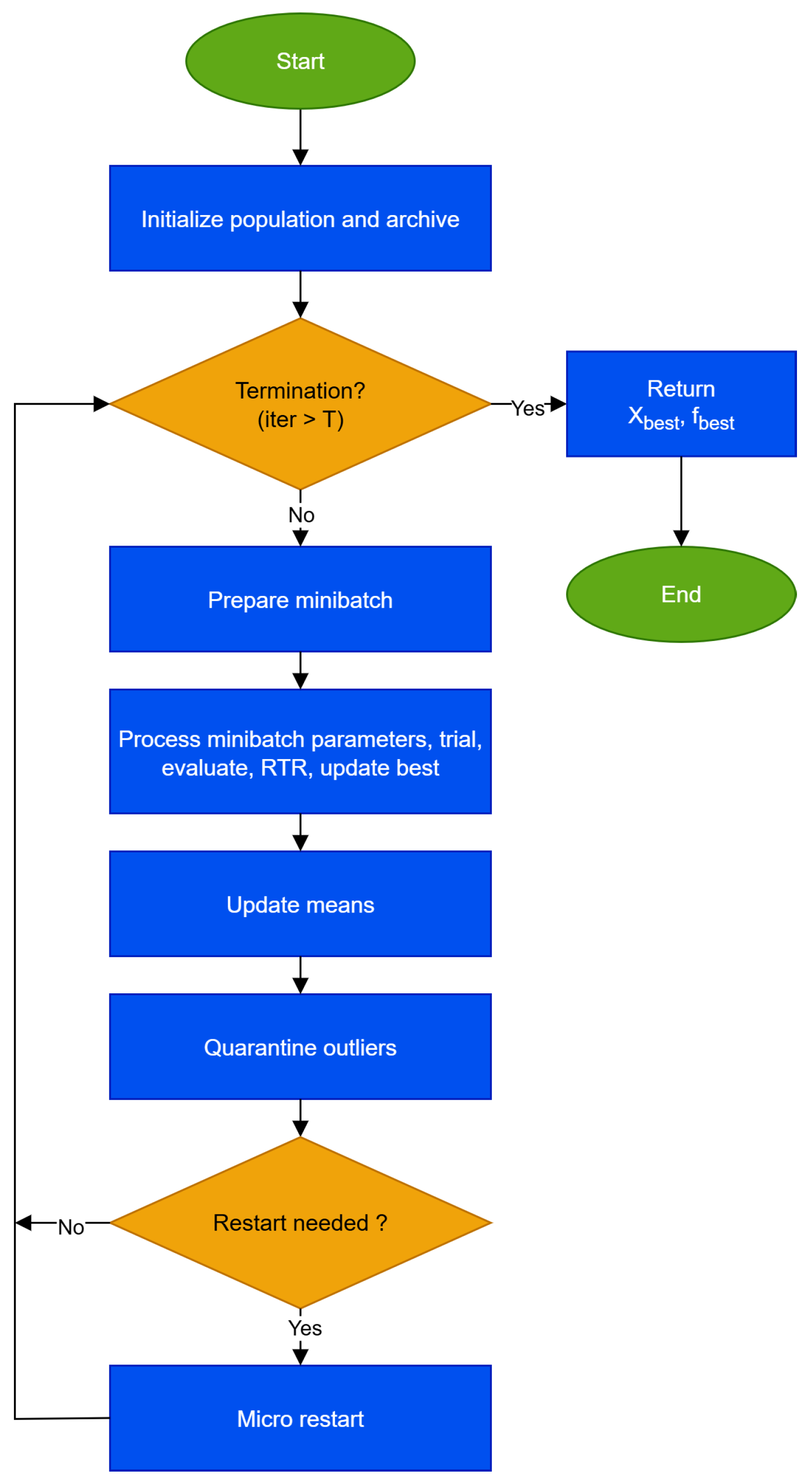



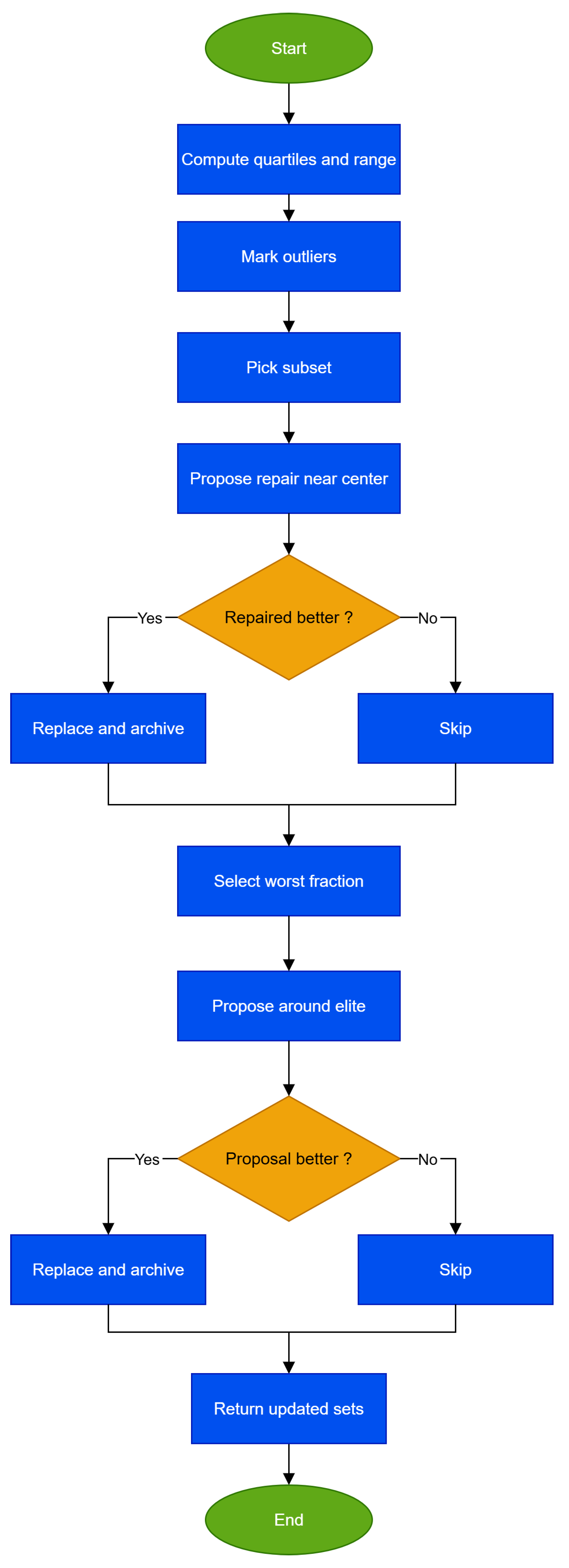
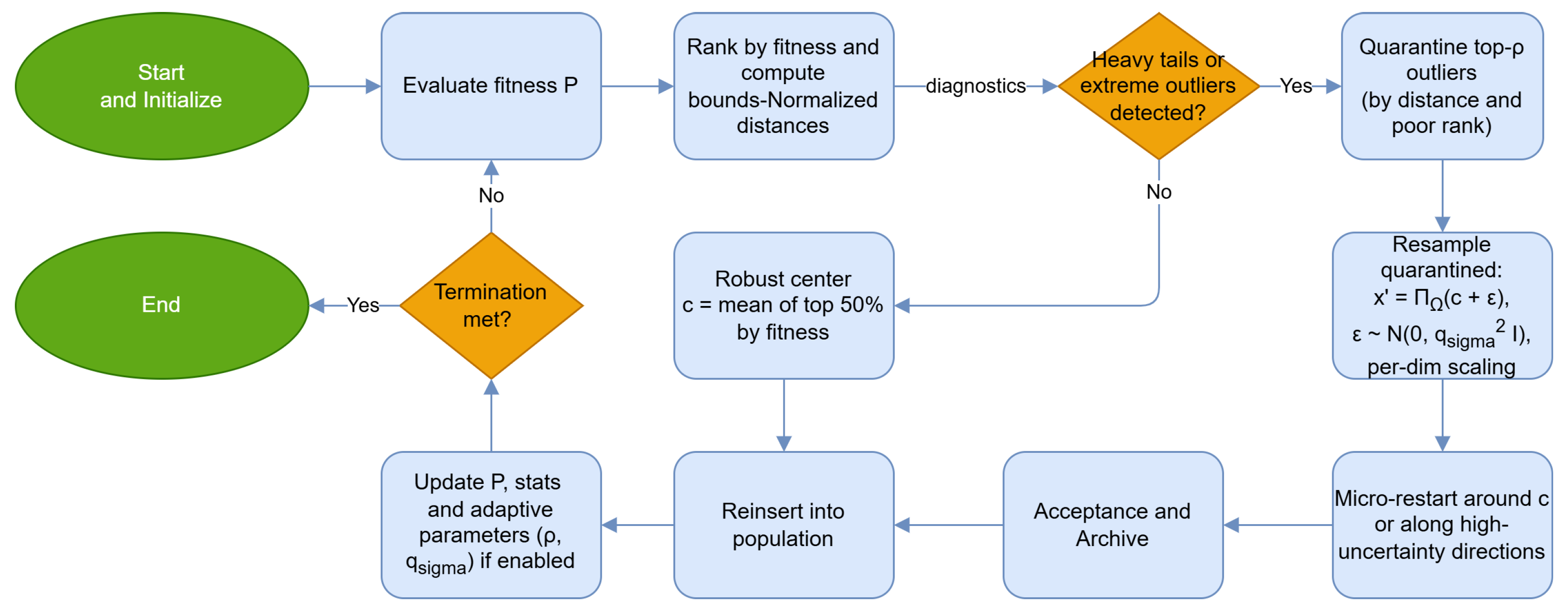


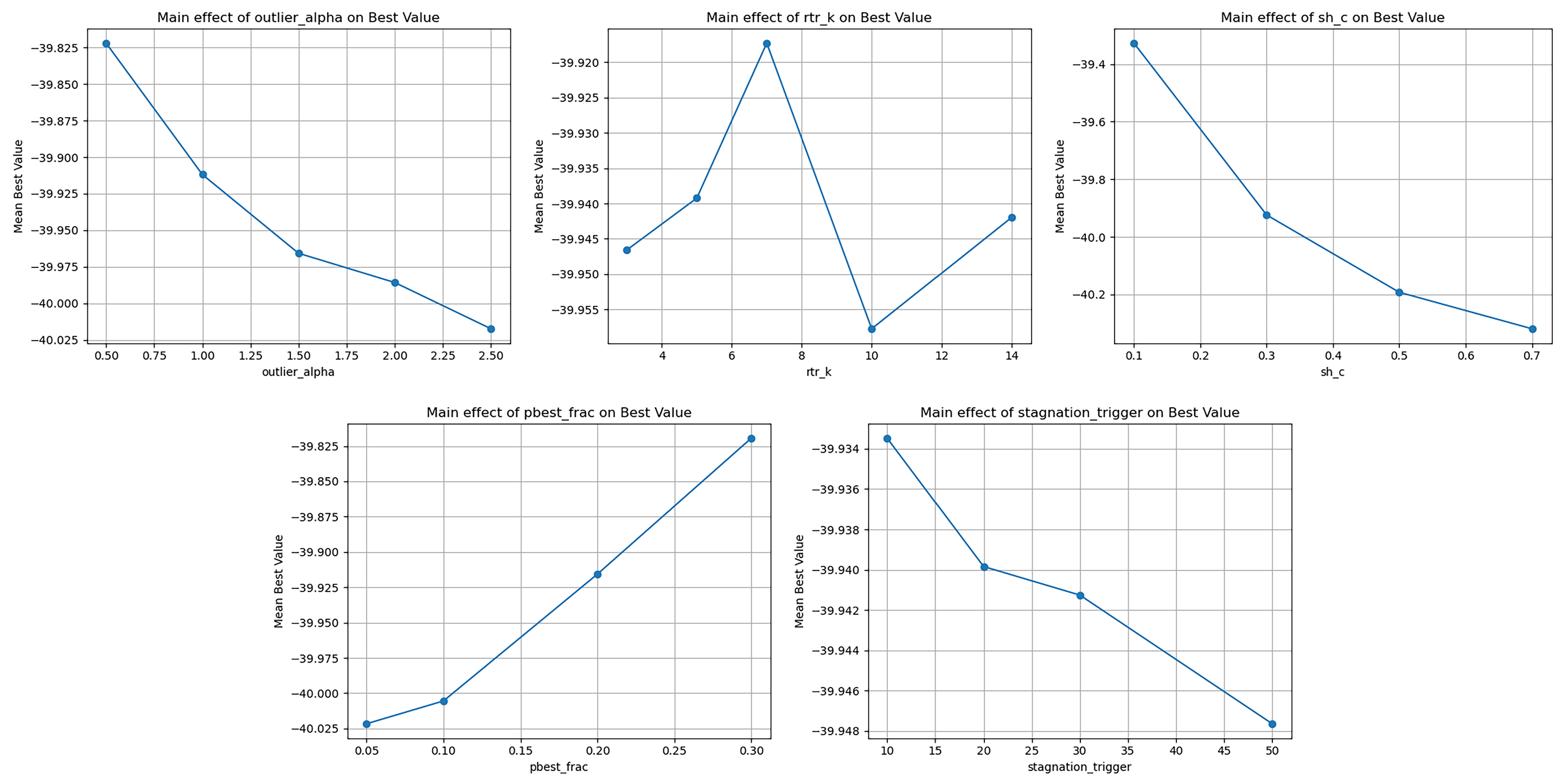
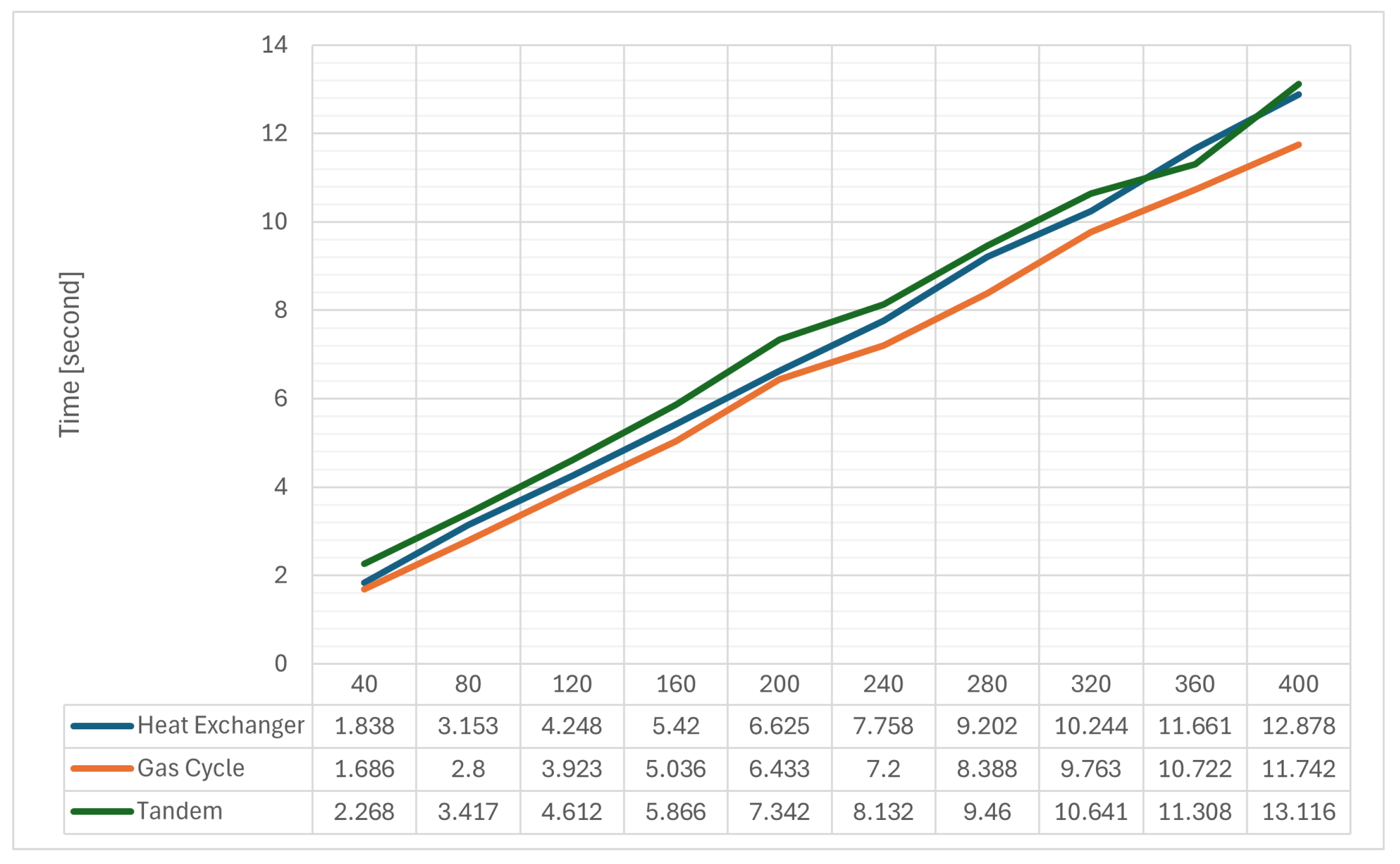
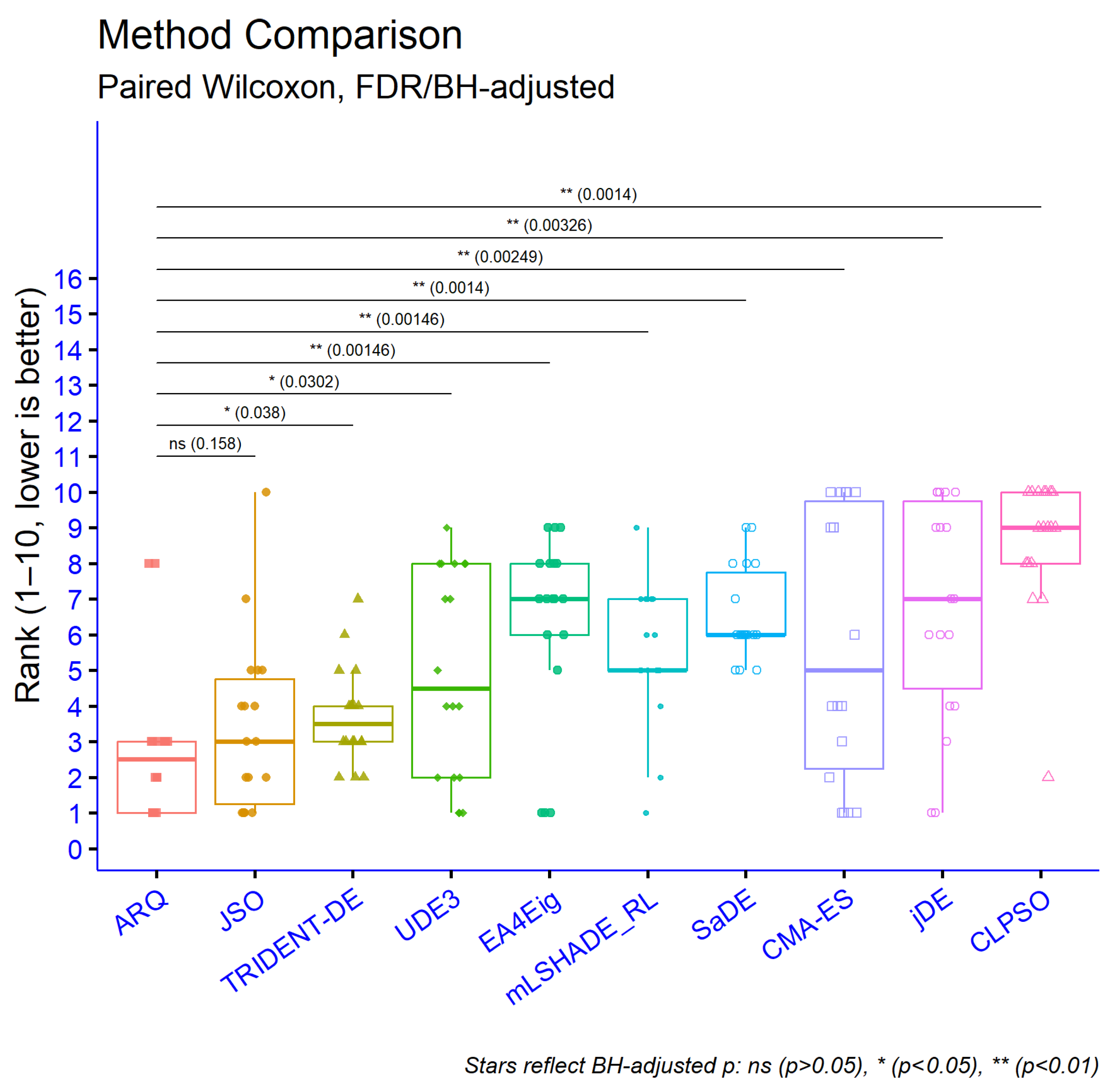

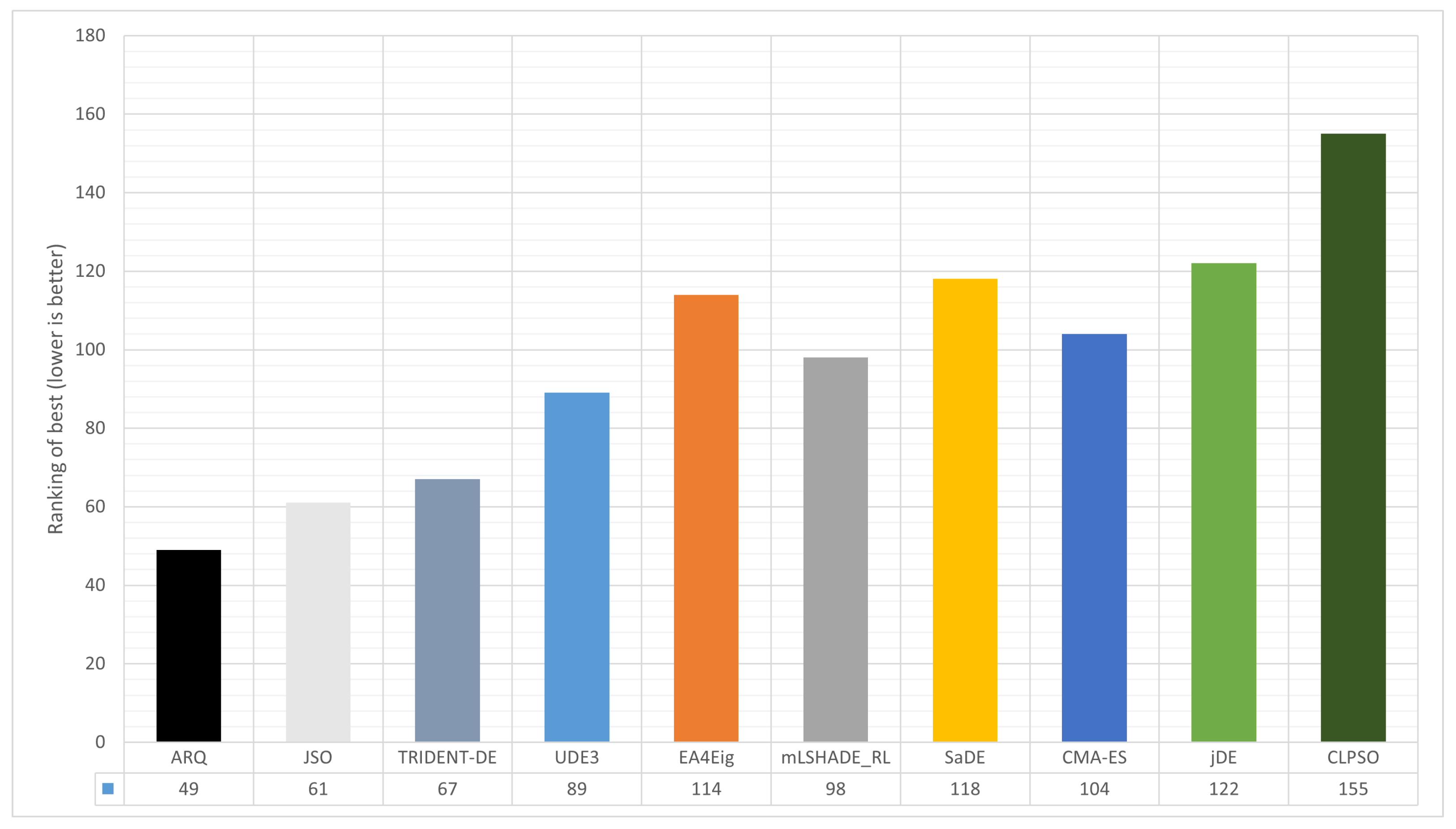



| Name | Value | Description |
|---|---|---|
| N | 100 | Population size |
| T | 150,000 | Maximum evaluations |
| p | 0.12 | Top fraction for pbest |
| 0.60 | Agents updated per step | |
| 0.6 | Mean scale factor | |
| 0.85 | Mean crossover rate. | |
| 1.0 | Outlier threshold coeff in | |
| 0.08 | Outliers repaired fraction | |
| w | 0.08 | Worst frac for micro-restart |
| 0.10 | SH learning rate | |
| 0.05 | F sample min | |
| 1.40 | F sample max | |
| 0.0 | sample min | |
| 1.0 | sample max | |
| 1.5 | Archive capacity | |
| 7 | RTR neighborhood size | |
| 14 | RTR pool size | |
| 0.0 | RTR min gain | |
| 0.10 | Quarantine perturb scale | |
| 24 | No-improve trigger | |
| 0.18 | Restart noise stdev |
| Name | Value | Description |
|---|---|---|
| N | 100 | Population size for all methods |
| JSO | ||
| 18 | Initial population size | |
| H | 20 | Memory size for success-history means / |
| 0.11 | Fraction for p-best selection (top-p set). | |
| 1 | Archive size as multiple of NP0 (i.e., archiveMax = archive_rate × NP0). | |
| CLPSO | ||
| 0.3 | Comprehensive learning probability | |
| 1.49445 | Cognitive weight | |
| 0.729 | Inertia weight | |
| 0.01 | Mutation rate | |
| 1.49445 | Social weight | |
| CMA-ES | ||
| Population size | ||
| EA4Eig | ||
| 100 | Archive size for JADE-style mutation | |
| 5 | Recompute eigenbasis every k iterations | |
| 1 | Upper bound for | |
| 1 | Upper bound for F | |
| 0 | Lower bound for | |
| 0.1 | Lower bound for F | |
| 0.2 | pbest fraction (current-to-pbest/1/bin) | |
| 0.1 | Self-adaptation prob. for | |
| 0.1 | Self-adaptation prob. for F | |
| mLSHADE_RL | ||
| 500 | Archive size | |
| 10 | Success-history memory size | |
| 4 | Minimum population size | |
| 0.2 | Maximum pbest fraction | |
| 0.05 | Minimum pbest fraction | |
| SaDE | ||
| 0.1 | Std for sampling | |
| 0.1 | Scale for Cauchy F sampling | |
| 0.5 | Initial mean | |
| 0.7 | Initial F mean | |
| 25 | Iterations per adaptation window | |
| UDE3 | ||
| 4 | Minimum population size. | |
| 10 | Success-history memory size | |
| 100 | Archive size | |
| 0.05 | Minimum pbest fraction | |
| 0.2 | Maximum pbest fraction. | |
| TRIDENT-DE. The parameters for this method are mentioned in Table in [41]. | ||
| Problem | Formula | Dim | Constraints/Bounds |
|---|---|---|---|
| Parameter Estimation for Frequency-Modulated Sound Waves [44,45,46] | | 6 | |
| Lennard-Jones Potential (atoms: 10, 13, 38) [47] | 24, 43, 108 | | |
| Bifunctional Catalyst Blend Optimal Control [48,49,50] | , , , , , | 1 | |
| Optimal Control of a Non-Linear Stirred Tank Reactor [51,52,53] | , | 1 | |
| Tersoff Potential for Model Si (B) [54,55] | where , : cutoff function with : angle parameter | 30 | |
| Tersoff Potential for model Si (C) [54,55] | | 30 | |
| Spread Spectrum Radar Polyphase Code Design [56] | , | 20 | |
| Transmission Network Expansion Planning [57] | | 7 | |
| Electricity Transmission Pricing [58] | | 126 | |
| Circular Antenna Array Design [59] | | 12 | |
| Cassini 2: Spacecraft Trajectory Optimization Problem [60] | | 10 | |
| Wireless Coverage Antenna Placement [61,62] | | 30 | |
| Dynamic Economic Dispatch 1 [63] | | 120 | |
| Dynamic Economic Dispatch 2 [63] | | 216 | |
| Static Economic Load Dispatch (1, 2, 3, 4, 5) [63] | | 6 13 15 40 140 | See Technical Report of CEC2011 |
| Parameter | Value | Mean | Min | Max | Iters | Main Effect Range |
|---|---|---|---|---|---|---|
| 0.5 | 2978.9797 | 2967.2491 | 3169.5417 | 9600 | 0.1594 | |
| 1 | 2978.9852 | 2967.2491 | 3169.5417 | 9600 | ||
| 1.5 | 2979.0918 | 2967.2491 | 3169.5417 | 9600 | ||
| 2 | 2978.9324 | 2967.2491 | 3166.8100 | 9600 | ||
| 2.5 | 2978.9569 | 2967.2491 | 3166.8100 | 9600 | ||
| 3 | 2978.9785 | 2967.2491 | 3169.5417 | 9600 | 0.0748 | |
| 5 | 2979.0218 | 2967.2491 | 3169.5417 | 9600 | ||
| 7 | 2978.9469 | 2967.2491 | 3169.5417 | 9600 | ||
| 10 | 2979.0129 | 2967.2491 | 3169.5417 | 9600 | ||
| 14 | 2978.9860 | 2967.2491 | 3166.8100 | 9600 | ||
| 0.1 | 2979.0735 | 2967.2491 | 3169.5417 | 12,000 | 0.2084 | |
| 0.3 | 2978.8650 | 2967.2491 | 3169.5417 | 12,000 | ||
| 0.5 | 2979.0562 | 2967.2491 | 3169.5417 | 12,000 | ||
| 0.7 | 2979.0562 | 2967.2491 | 3166.8100 | 12,000 | ||
| p | 0.05 | 2979.4978 | 2967.2491 | 3169.5417 | 12,000 | 0.9368 |
| 0.1 | 2979.0781 | 2967.2491 | 3169.5417 | 12,000 | ||
| 0.2 | 2978.8201 | 2967.2491 | 3167.0430 | 12,000 | ||
| 0.3 | 2978.5609 | 2967.2491 | 3169.5417 | 12,000 | ||
| 10 | 2979.0096 | 2967.2491 | 3169.5417 | 12,000 | 0.0990 | |
| 20 | 2978.9588 | 2967.2491 | 3166.8100 | 12,000 | ||
| 30 | 2979.0438 | 2967.2491 | 3169.5417 | 12,000 | ||
| 50 | 2978.9447 | 2967.2491 | 3169.5417 | 12,000 |
| Parameter | Value | Mean | Min | Max | Iters | Main Effect Range |
|---|---|---|---|---|---|---|
| 0.5 | 130,643.6614 | 130,642.7267 | 130,668.1727 | 9600 | 0.2952 | |
| 1 | 130,643.6546 | 130,642.7276 | 130,667.1070 | 9600 | ||
| 1.5 | 130,643.7393 | 130,642.7131 | 130,662.7681 | 9600 | ||
| 2 | 130,643.9058 | 130,642.7216 | 130,709.2564 | 9600 | ||
| 2.5 | 130,643.9498 | 130,642.7275 | 130,702.0175 | 9600 | ||
| 3 | 130,643.7943 | 130,642.7253 | 130,709.2564 | 9600 | 0.0309 | |
| 5 | 130,643.7775 | 130,642.7275 | 130,702.0175 | 9600 | ||
| 7 | 130,643.7889 | 130,642.7233 | 130,684.7783 | 9600 | ||
| 10 | 130,643.7634 | 130,642.7282 | 130,662.7681 | 9600 | ||
| 14 | 130,643.7869 | 130,642.7131 | 130,667.5166 | 9600 | ||
| 0.1 | 130,643.7862 | 130,642.7282 | 130,680.0939 | 12,000 | 0.0295 | |
| 0.3 | 130,643.7630 | 130,642.7168 | 130,680.9305 | 12,000 | ||
| 0.5 | 130,643.7870 | 130,642.7131 | 130,709.2564 | 12,000 | ||
| 0.7 | 130,643.7925 | 130,642.7253 | 130,702.0175 | 12,000 | ||
| p | 0.05 | 130,643.6902 | 130,642.7131 | 130,709.2564 | 12,000 | 0.3111 |
| 0.1 | 130,643.6697 | 130,642.7259 | 130,702.0175 | 12,000 | ||
| 0.2 | 130,643.7879 | 130,642.7393 | 130,684.7783 | 12,000 | ||
| 0.3 | 130,643.9809 | 130,642.7459 | 130,682.8584 | 12,000 | ||
| 10 | 130,643.7790 | 130,642.7233 | 130,709.2564 | 12,000 | 0.0164 | |
| 20 | 130,643.7830 | 130,642.7294 | 130,684.7783 | 12,000 | ||
| 30 | 130,643.7915 | 130,642.7253 | 130,702.0175 | 12,000 | ||
| 50 | 130,643.7751 | 130,642.7131 | 130,680.0939 | 12,000 |
| Parameter | Value | Mean | Min | Max | Iters | Main Effect Range |
|---|---|---|---|---|---|---|
| 0.5 | −39.8220 | −44.32680 | −35.8189 | 9600 | 0.1952 | |
| 1 | −39.9118 | −44.32680 | −35.1252 | 9600 | ||
| 1.5 | −39.9657 | −44.32680 | −35.3909 | 9600 | ||
| 2 | −39.9857 | −44.32680 | −36.0638 | 9600 | ||
| 2.5 | −40.0173 | −44.32680 | −35.3308 | 9600 | ||
| 3 | −39.9465 | −44.32680 | −35.1252 | 9600 | 0.0404 | |
| 5 | −39.9392 | −44.32680 | −35.3909 | 9600 | ||
| 7 | −39.9172 | −44.32680 | −35.3308 | 9600 | ||
| 10 | −39.9577 | −44.32680 | −35.4352 | 9600 | ||
| 14 | −39.9419 | −44.32680 | −35.8104 | 9600 | ||
| 0.1 | −39.3275 | −44.32680 | −35.3909 | 12,000 | 0.9911 | |
| 0.3 | −39.9237 | −44.32680 | −35.5921 | 12,000 | ||
| 0.5 | −40.1921 | −44.32680 | −35.1252 | 12,000 | ||
| 0.7 | −40.3186 | −44.32680 | −36.0487 | 12,000 | ||
| p | 0.05 | −40.0216 | −44.32680 | −35.1252 | 12,000 | 0.2021 |
| 0.1 | −40.0054 | −44.32680 | −35.3909 | 12,000 | ||
| 0.2 | −39.9157 | −44.32680 | −35.3308 | 12,000 | ||
| 0.3 | −39.8194 | −44.32680 | −35.4769 | 12,000 | ||
| 10 | −39.9334 | −44.32680 | −35.3308 | 12,000 | 0.0141 | |
| 20 | −39.9398 | −44.32680 | −35.8387 | 12,000 | ||
| 30 | −39.9412 | −44.32680 | −35.7413 | 12,000 | ||
| 50 | −39.94763 | −44.32680 | −35.1252 | 12,000 |
| Problem | ARQ Best Mean | JSO Best Mean | TRIDENT-DE Best Mean | UDE3 Best Mean | EA4Eig Best Mean | mLSHADE_RL Best Mean | SaDE Best Mean | CMA-ES Best Mean | jDE Best Mean | CLPSO Best Mean |
|---|---|---|---|---|---|---|---|---|---|---|
| Lennard-Jones Potential (10 atoms) | −28.42253189 | −27.68965427 | −28.42253189 | −17.60964115 | −22.47842596 | −28.42252711 | −22.86077544 | −28.42253189 | −15.91366007 | −16.59269921 |
| −27.62259837 | −26.43980674 | −27.19833972 | −16.33758634 | −19.48663385 | −23.77189104 | −21.22806787 | −27.52754934 | −13.75563015 | −13.55503647 | |
| Lennard-Jones Potential (13 atoms) | −44.12080311 | −36.56391435 | −41.39220729 | −21.90945922 | −28.01101572 | −40.6992486 | −29.31393114 | −44.32680142 | −18.77073675 | −18.00250514 |
| −38.97673056 | −35.18151099 | −39.14390841 | −19.49372047 | −24.58810405 | −30.67706246 | −27.48874237 | −41.44245617 | −15.4243072 | −15.86691988 | |
| Lennard-Jones Potential (38 atoms) | −157.3383508 | −73.79663557 | −125.1886792 | −2.015038465 | −55.05415428 | −120.0680452 | −68.91313107 | −167.7369019 | 9186.25096 | 330.9934848 |
| −125.0267732 | −67.48713618 | −107.1751456 | 140.2211284 | −3.350181902 | −73.95117658 | −45.80265994 | −163.6091673 | 9186.25096 | 1087.035295 | |
| Tersoff Potential for model Si (B) | −29.30289228 | −28.73373322 | −28.93480467 | −25.43447342 | −26.90746941 | −28.12281867 | −26.65687822 | −28.33045002 | −24.75133772 | −22.67387001 |
| −28.279056 | −28.0408539 | −27.70615763 | −23.30318979 | −24.69059932 | −25.49977206 | −25.27422603 | −27.38991233 | −22.94168766 | −21.21150428 | |
| Tersoff Potential for model Si (C) | −33.78825497 | −33.24194738 | −33.8820283 | −29.30227462 | −30.88865174 | −31.70444684 | −30.94469385 | −32.50963421 | −29.44789882 | −26.88039528 |
| −32.71055796 | −32.47083022 | −31.91749393 | −27.53891341 | −29.0199918 | −29.44303263 | −29.70029831 | −31.53772845 | −29.44789882 | −24.653633 | |
| Parameter Estimation for Frequency-ModulatedSound Waves | 0.116157535 | 0 | 0.15272453 | 0.116157535 | 0.148007602 | 0.210122687 | 0.131483748 | |||
| 0.122436815 | 0.114197358 | 0.134324544 | 0.103406319 | 0.213099692 | 0.208210846 | 0.148007602 | 0.267329914 | 0.132539923 | 0.212498169 | |
| Circular Antenna Array Design | 0.006809638 | 0.006809638 | 0.006809638 | 0.006809665 | 0.006809638 | 0.006809662 | 0.006814682 | 0.007253731 | 0.00681715 | 0.006933401 |
| 0.006810417 | 0.006819653 | 0.006809683 | 0.006817385 | 0.006809638 | 0.006825338 | 0.00790701 | 0.008755359 | 0.006835764 | 0.051815518 | |
| Spread Spectrum Radar Polyphase Code Design | 0.006902215 | 0.331062321 | 0.014426836 | 0.953872709 | 0.601567824 | 0.074552911 | 0.550837019 | 0.062519409 | 1.005739785 | 0.860294378 |
| 0.351872002 | 0.44224577 | 0.26254527 | 1.206577385 | 0.869257599 | 0.535028919 | 0.803527605 | 0.197713522 | 1.331416957 | 1.273200439 | |
| Cassini 2: Spacecraft Trajectory Optimization Problem | 0.000926598 | 0.039231105 | 1.22633022 | |||||||
| 0.008206106 | 0.070230417 | 5.929143722 | 0.000285411 | 3.639687905 | ||||||
| Wireless Coverage Antenna Placement | 0.946350736 | 0.946350736 | 0.946350736 | 0.946350736 | 0.946655032 | 0.946350736 | 0.946361987 | 1.18939375 | 0.946350736 | 0.946365969 |
| 0.946371023 | 0.94636088 | 0.94662124 | 0.946502884 | 0.946659575 | 0.946875107 | 0.946688757 | 1.190699803 | 0.946401452 | 0.946727502 | |
| Transmission Network Expansion Planning | 4.485292926 | 4.485292926 | 4.485292926 | 4.485295106 | 4.485292926 | 4.485292926 | 4.485299525 | 4.485292926 | 4.485292926 | 4.486699087 |
| 4.485292926 | 4.485292926 | 4.485304003 | 4.485304003 | 4.485292926 | 4.485292926 | 4.485311924 | 4.485292948 | 4.485292926 | 4.495857336 | |
| Dynamic Economic Dispatch 1 | 130,642.8565 | 130,661.111 | 130,850.0389 | 130,693.5423 | 130,694.29 | 130,882.0646 | 131,010.8769 | 130,650.9354 | 131,225.2453 | 131,834.4235 |
| 130,643.4825 | 130,681.9224 | 130,931.1074 | 130,717.6052 | 130,862.9893 | 130,955.331 | 131,099.1959 | 130,654.2758 | 131,225.2453 | 132,151.5397 | |
| Dynamic Economic Dispatch 2 | 165,304.7824 | 171,554.4678 | 165,980.9574 | 164,946.164 | 172,067.4426 | 167,519.3281 | 167,908.0605 | 165,847.1092 | 186,121.2812 | 177,120.3822 |
| 165,662.994 | 172,600.3374 | 166,478.1534 | 165,614.9256 | 172,931.6964 | 168,275.5429 | 168,495.9731 | 166,233.691 | 190,793.5621 | 178,190.4198 | |
| Static Economic Load Dispatch 1 | 2967.249196 | 2967.249196 | 2967.249196 | 2967.249196 | 2979.803369 | 2967.249196 | 2967.249196 | 2967.249586 | 2967.249196 | 2967.249197 |
| 2978.966424 | 2973.649521 | 2975.721343 | 2976.057657 | 2979.803369 | 2976.956221 | 2976.139816 | 3108.931917 | 2967.659992 | 2973.33009 | |
| Static Economic Load Dispatch 2 | 17,866.8974 | 17,864.04428 | 17,879.73679 | 17,864.69687 | 18,006.65976 | 17,882.28384 | 17,892.38129 | 17,960.84734 | 17,867.57447 | 17,910.47794 |
| 17,915.76463 | 17,864.65039 | 17,928.65603 | 17,890.83413 | 18,063.12085 | 17,950.15892 | 17,958.94204 | 18,077.58006 | 17,992.09486 | 18,089.83526 | |
| Static Economic Load Dispatch 3 | 32,367.57735 | 32,367.57735 | 32,367.57735 | 32,367.57735 | 32,415.80367 | 32,367.57765 | 32,376.02197 | 32,645.34102 | 32,391.64981 | 32,384.85409 |
| 32,539.37396 | 32,367.57735 | 32,440.87752 | 32,400.86337 | 32,573.03572 | 32,491.57235 | 32,491.28971 | 32,867.1729 | 32,476.58405 | 32,532.19143 | |
| Static Economic Load Dispatch 4 | 121,093.4505 | 121,078.7215 | 121,071.4654 | 121,066.9247 | 121,197.2468 | 121,085.9922 | 121,195.4656 | 122,350.1013 | 121,234.0466 | 121,328.7006 |
| 121,331.4674 | 508,807.9108 | 121,422.9908 | 121,197.2468 | 121,545.1315 | 121,308.5801 | 121,517.4918 | 122,957.6217 | 121,526.7414 | 121,541.4182 | |
| Static Economic Load Dispatch 5 | 508,614.1309 | 508,807.9108 | 508,663.8176 | 508,661.3113 | 508,872.6908 | 508,851.668 | 508,985.9092 | 508,717.1467 | 511,174.5326 | 509,025.7426 |
| 508,614.8964 | 508,858.0755 | 508,703.0424 | 508,676.4938 | 508,986.6092 | 508,988.5396 | 509,125.2079 | 508,770.1661 | 562,012.6548 | 509,080.3439 |
| Problem | ARQ | JSO | TRIDENT-DE | UDE3 | EA4Eig | mLSHADERL | SaDE | CMA-ES | jDE | CLPSO |
|---|---|---|---|---|---|---|---|---|---|---|
| Lennard-Jones Potential (10 atoms) | 1 | 4 | 3 | 8 | 7 | 5 | 6 | 1 | 9 | 10 |
| Lennard-Jones Potential (13 atoms) | 3 | 4 | 2 | 8 | 7 | 5 | 6 | 1 | 10 | 9 |
| Lennard-Jones Potential (38 atoms) | 2 | 5 | 3 | 8 | 7 | 4 | 6 | 1 | 10 | 9 |
| Tersoff Potential for model Si (B) | 1 | 2 | 3 | 8 | 7 | 5 | 6 | 4 | 9 | 10 |
| Tersoff Potential for model Si (C) | 1 | 2 | 3 | 9 | 8 | 7 | 5 | 4 | 6 | 10 |
| Parameter Estimation for Frequency-Modulated Sound Waves | 3 | 2 | 5 | 1 | 9 | 7 | 6 | 10 | 4 | 8 |
| Circular Antenna Array Design | 3 | 5 | 2 | 4 | 1 | 6 | 8 | 9 | 7 | 10 |
| Spread Spectrum Radar PolyphaseCode Design | 3 | 4 | 2 | 8 | 7 | 5 | 6 | 1 | 10 | 9 |
| Cassini 2: Spacecraft TrajectoryOptimization Problem | 3 | 1 | 4 | 7 | 1 | 5 | 8 | 10 | 6 | 9 |
| Wireless Coverage Antenna Placement | 2 | 1 | 5 | 4 | 6 | 9 | 7 | 10 | 3 | 8 |
| Transmission Network ExpansionPlanning | 1 | 1 | 7 | 7 | 1 | 1 | 9 | 6 | 1 | 10 |
| Dynamic Economic Dispatch 1 | 1 | 3 | 6 | 4 | 5 | 7 | 8 | 2 | 9 | 10 |
| Dynamic Economic Dispatch 2 | 2 | 7 | 4 | 1 | 8 | 5 | 6 | 3 | 10 | 9 |
| Static Economic Load Dispatch 1 | 8 | 3 | 4 | 5 | 9 | 7 | 6 | 10 | 1 | 2 |
| Static Economic Load Dispatch 2 | 3 | 1 | 4 | 2 | 8 | 5 | 6 | 9 | 7 | 10 |
| Static Economic Load Dispatch 3 | 8 | 1 | 3 | 2 | 9 | 6 | 5 | 10 | 4 | 7 |
| Static Economic Load Dispatch 4 | 3 | 10 | 4 | 1 | 8 | 2 | 5 | 9 | 6 | 7 |
| Static Economic Load Dispatch 5 | 1 | 5 | 3 | 2 | 6 | 7 | 9 | 4 | 10 | 8 |
| Problem | ARQ | JSO | TRIDENT-DE | UDE3 | EA4Eig | mLSHADERL | SaDE | CMA-ES | jDE | CLPSO |
|---|---|---|---|---|---|---|---|---|---|---|
| Lennard-Jones Potential (10 atoms) | 2 | 5 | 3 | 8 | 7 | 4 | 6 | 1 | 9 | 10 |
| Lennard-Jones Potential (13 atoms) | 2 | 5 | 3 | 8 | 7 | 4 | 6 | 1 | 10 | 9 |
| Lennard-Jones Potential (38 atoms) | 1 | 3 | 2 | 8 | 6 | 5 | 7 | 4 | 9 | 10 |
| Tersoff Potential for model Si (B) | 2 | 3 | 1 | 9 | 7 | 5 | 6 | 4 | 8 | 10 |
| Tersoff Potential for model Si (C) | 1 | 4 | 5 | 1 | 9 | 5 | 8 | 10 | 1 | 7 |
| Parameter Estimation for Frequency-Modulated Sound Waves | 1 | 1 | 1 | 6 | 1 | 5 | 7 | 10 | 8 | 9 |
| Circular Antenna Array Design | 1 | 5 | 2 | 9 | 7 | 4 | 6 | 3 | 10 | 8 |
| Spread Spectrum Radar PolyphaseCode Design | 1 | 1 | 6 | 8 | 1 | 5 | 9 | 1 | 7 | 10 |
| Cassini 2: Spacecraft TrajectoryOptimization Problem | 1 | 1 | 1 | 1 | 9 | 1 | 7 | 10 | 1 | 8 |
| Wireless Coverage AntennaPlacement | 1 | 1 | 1 | 8 | 1 | 1 | 9 | 1 | 1 | 10 |
| Transmission Network ExpansionPlanning | 1 | 3 | 6 | 4 | 5 | 7 | 8 | 2 | 9 | 10 |
| Dynamic Economic Dispatch 1 | 2 | 7 | 4 | 1 | 8 | 5 | 6 | 3 | 10 | 9 |
| Dynamic Economic Dispatch 2 | 1 | 1 | 1 | 1 | 10 | 1 | 1 | 9 | 1 | 8 |
| Static Economic Load Dispatch 1 | 3 | 1 | 5 | 2 | 10 | 6 | 7 | 9 | 4 | 8 |
| Static Economic Load Dispatch 2 | 1 | 1 | 1 | 1 | 9 | 5 | 6 | 10 | 8 | 7 |
| Static Economic Load Dispatch 3 | 5 | 3 | 2 | 1 | 7 | 4 | 6 | 10 | 8 | 9 |
| Static Economic Load Dispatch 4 | 1 | 5 | 3 | 2 | 7 | 6 | 8 | 4 | 10 | 9 |
| Static Economic Load Dispatch 5 | 1 | 2 | 3 | 4 | 5 | 6 | 7 | 8 | 9 | 10 |
| Algorithm | Best Total Rank | Mean Total Rank | Overall Rank Sum | Average Rank |
|---|---|---|---|---|
| ARQ | 49 | 28 | 77 | 2.139 |
| JSO | 61 | 52 | 113 | 3.139 |
| TRIDENT-DE | 67 | 50 | 117 | 3.250 |
| UDE3 | 89 | 82 | 171 | 4.750 |
| mLSHADE_RL | 98 | 79 | 177 | 4.917 |
| CMA-ES | 104 | 100 | 204 | 5.666 |
| EA4Eig | 114 | 116 | 230 | 6.389 |
| SaDE | 118 | 120 | 238 | 6.611 |
| jDE | 122 | 123 | 245 | 6.806 |
| CLPSO | 155 | 161 | 316 | 8.778 |
Disclaimer/Publisher’s Note: The statements, opinions and data contained in all publications are solely those of the individual author(s) and contributor(s) and not of MDPI and/or the editor(s). MDPI and/or the editor(s) disclaim responsibility for any injury to people or property resulting from any ideas, methods, instructions or products referred to in the content. |
© 2025 by the authors. Licensee MDPI, Basel, Switzerland. This article is an open access article distributed under the terms and conditions of the Creative Commons Attribution (CC BY) license (https://creativecommons.org/licenses/by/4.0/).
Share and Cite
Charilogis, V.; Tsoulos, I.G.; Gianni, A.M.; Tsalikakis, D. ARQ: A Cohesive Optimization Design for Stable Performance on Noisy Landscapes. Appl. Sci. 2025, 15, 12180. https://doi.org/10.3390/app152212180
Charilogis V, Tsoulos IG, Gianni AM, Tsalikakis D. ARQ: A Cohesive Optimization Design for Stable Performance on Noisy Landscapes. Applied Sciences. 2025; 15(22):12180. https://doi.org/10.3390/app152212180
Chicago/Turabian StyleCharilogis, Vasileios, Ioannis G. Tsoulos, Anna Maria Gianni, and Dimitrios Tsalikakis. 2025. "ARQ: A Cohesive Optimization Design for Stable Performance on Noisy Landscapes" Applied Sciences 15, no. 22: 12180. https://doi.org/10.3390/app152212180
APA StyleCharilogis, V., Tsoulos, I. G., Gianni, A. M., & Tsalikakis, D. (2025). ARQ: A Cohesive Optimization Design for Stable Performance on Noisy Landscapes. Applied Sciences, 15(22), 12180. https://doi.org/10.3390/app152212180









